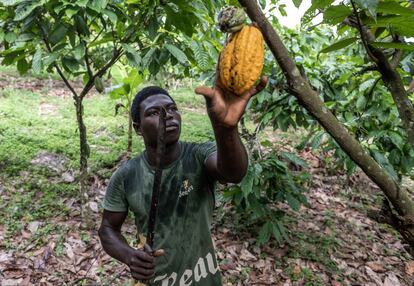Cocoa woes makes chocolate companies bitter
Raw materials have reached levels not seen since the 1970s due to climate change and reduced product availability

Devotees say that buying a piece of chocolate is investing in the most luxurious of earthly treasures. For a small sum you can buy unparalleled delight that lasts for days and even weeks. This everyday pleasure, however, is becoming more expensive around the world. Cocoa prices have skyrocketed in international markets to levels not seen in more than four decades, due to a dangerous combination of factors that include suspended production in West Africa, where two thirds of the global harvest comes from; a reduction in stocks, which are at their lowest level in three decades; and the advance of the effects of climate change, which threaten plantations with constant rains.
This year, the London market — the world benchmark — has seen the average monthly prices of cocoa futures reach their highest level since the late 1970s. “The price graph flatlined over the last two years because supply has been greater than demand,” says Jonathan Parkman, co-head of agriculture and commodities brokerage expert at Marex Financial. After the outbreak of the pandemic, the cocoa business — whose biggest buyers are companies that make chocolates — has suffered various setbacks. The health crisis interrupted the labor supply, as well as various inputs, such as fertilizers and phytosanitary products. Added to this were the logistical problems of transporting cocoa to the markets with the greatest consumption: the United States and Europe. Despite these challenges, production expanded in 2020 and hit a record level, thus growing stocks.
But on the other side of the coin, the story was different for chocolate consumption. “In 2020, global sales decreased by 0.2% in value,” says Margaux Lainé, a research consultant at Euromonitor International. The drop was not generalized to all regions. In the Asia-Pacific and Latin American markets sales collapsed, while in North America and Western Europe there was an increase. “In Asian countries, 25% of chocolate is intended for gifts and due to lockdown, sales decreased,” she highlights. Conversely, in Europe and North America, chocolate consumption increased due to lockdown. “Consumers were looking for ways to treat themselves,” explains Lainé. And for 2021 the appetite was even greater. With the arrival of the vaccine, the alarm over Covid-19 decreased, and many people felt more inclined to get together for celebrations, which generated an increase in sales of seasonal chocolates. “People bought chocolates for holidays such as Valentine’s Day, Easter, and Mother’s Day,” the Euromonitor specialist says.
But then Russia invaded Ukraine and the world turned upside down. The uncertainty about energy supply took its toll mainly on the industries of European countries. This led chocolate companies to place fewer orders for cocoa, as the outlook did not look very rosy. The situation, however, was not as difficult as expected. The Old Continent endured the hardship of abandoning Russian gas, which provided 40% of what the EU consumed before the armed conflict. It was then that chocolate companies began to demand more cocoa, but they were competing for a supply that was already not enough. “In the last two years there have been global deficits in the availability of the product,” argues Pia Piggott, analyst at the Dutch bank Rabobank. “And now, possibly, we are heading into a third year,” she adds.
“Global demand for cocoa has exceeded global supply, therefore reducing stocks,” explains Bill Weatherburn, commodity economist at Capital Economics. In addition to this, crops in the Ivory Coast, the world’s largest producer, have been negatively affected by heavy rains. “The wet climate also facilitates the spread of diseases, which has put next year’s harvest at greater risk,” he adds. Added to this scenario are meteorological expectations that predict an El Niño event that will occur in the next nine months, and that will bring a drier climate in the area of greatest production. “The global cocoa supply is particularly vulnerable to adverse weather conditions in West Africa because around 75% of production comes from there,” Weatherburn adds. Producers have also had to face an increase in the price of fertilizers, many of them purchased from Russia.
This blend of ingredients is leaving the chocolate world a little bitter. In Europe, the increase in the price of chocolates (confectionery, bars, and gifts) was 13.3% in the first half of this year, compared to the same period in 2021, according to NielsenIQ. In the case of Spain, the increase has been 11%, higher than in Italy (10.2%) and France (10.3%). In the U.S., the price has been 20.7%. “Inflation [in general] contributes even more to the increase in prices,” says Lainé. Because not everything is cocoa. “When we look at the extent to which the price of the cocoa bean affects the total price of the chocolate bar, it is approximately 5% to 10%,” explains Parkman. “Although important, the rise is not as dramatic as one might think,” he comments.
Compound costs
A chocolate bar is not only made of chocolate. Just look at the list of ingredients on the packet and you will see that there is also sugar (whose price is sky-high: the international price of sugar has reached its highest in 11 years) and wheat, which has been convulsed by the armed conflict in Europe — Russia and Ukraine represent a quarter of world trade in the cereal. “The only thing that has decreased is the price of milk powder,” Piggott says. Its cost has fallen almost 40% from a record in March 2022, as the weak Chinese economy has curbed demand while producers have increased production.
Various companies, such as Lindt & Sprüngli and Hershey, have not ruled out further increases in the price of their products, according to Bloomberg. “Some companies are replacing natural ingredients with artificial ones,” explains Judith Ganes, founder and president of J. Ganes Consulting, which has been following the market for more than three decades. “Or, alternatively, they are reducing the size of their products.” These days, a sweet treat for yourself puts a little more pressure on your wallet.
Sign up for our weekly newsletter to get more English-language news coverage from EL PAÍS USA Edition
Tu suscripción se está usando en otro dispositivo
¿Quieres añadir otro usuario a tu suscripción?
Si continúas leyendo en este dispositivo, no se podrá leer en el otro.
FlechaTu suscripción se está usando en otro dispositivo y solo puedes acceder a EL PAÍS desde un dispositivo a la vez.
Si quieres compartir tu cuenta, cambia tu suscripción a la modalidad Premium, así podrás añadir otro usuario. Cada uno accederá con su propia cuenta de email, lo que os permitirá personalizar vuestra experiencia en EL PAÍS.
¿Tienes una suscripción de empresa? Accede aquí para contratar más cuentas.
En el caso de no saber quién está usando tu cuenta, te recomendamos cambiar tu contraseña aquí.
Si decides continuar compartiendo tu cuenta, este mensaje se mostrará en tu dispositivo y en el de la otra persona que está usando tu cuenta de forma indefinida, afectando a tu experiencia de lectura. Puedes consultar aquí los términos y condiciones de la suscripción digital.
More information
Últimas noticias
Most viewed
- Reinhard Genzel, Nobel laureate in physics: ‘One-minute videos will never give you the truth’
- Oona Chaplin: ‘I told James Cameron that I was living in a treehouse and starting a permaculture project with a friend’
- Pablo Escobar’s hippos: A serious environmental problem, 40 years on
- Chevy Chase, the beloved comedian who was a monster off camera: ‘Not everyone hated him, just the people who’ve worked with him’
- Why we lost the habit of sleeping in two segments and how that changed our sense of time











































